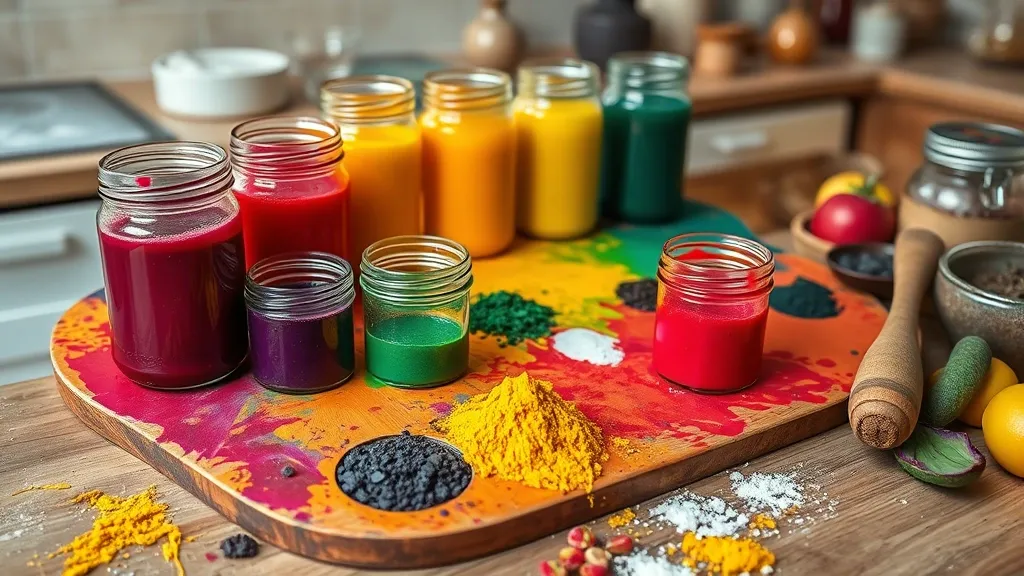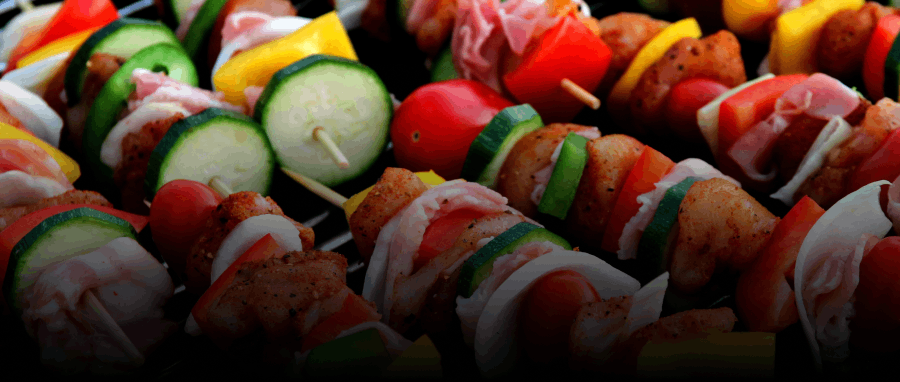The Colorful Alchemy: From Nature to Palette
You know, there’s something kinda magical about turning the natural world into vibrant colors that we can splash onto our food. It’s like alchemy, but without the beakers and lab coats (thank goodness, right?). Let’s dive into how we transform fruits, vegetables, and other goodies into those pretty hues that make our meals pop.
First off, nature’s got a whole toolbox filled with colors waiting to be used. Ever noticed how tomatoes are red, spinach is green, and blueberries are, well, blue? These colors come from pigments, which are basically tiny molecules that absorb light and reflect specific wavelengths. It’s like nature’s own little light show! Here are some common sources:
- Chlorophyll: This green powerhouse comes from plants, and it’s responsible for that fresh, leafy vibe we all love.
- Carotenoids: Found in carrots and sweet potatoes, these guys give off those warm yellows and oranges. They’re like the sunshine of the vegetable world!
- Anthocyanins: These are the reason for those gorgeous reds and purples in berries, grapes, and even red cabbage. It’s like a party in your pantry!
So, how do we get these colors from the plant to our plate? Well, it usually involves a bit of extraction. Think of it as doing a fancy dance to coax out the color. The process can vary—sometimes it’s as simple as juicing or blending, while other times it involves more complex methods like solvent extraction or even fermentation. Yep, it’s science, but it’s also art. And honestly, who doesn’t love a little bit of both?
What’s cool is that these natural colors are not just pretty—they can also come with health benefits. For example, carotenoids are known for their antioxidant properties (hello, healthy skin!) and anthocyanins can promote heart health. So, you’re not just adding color; you’re adding a little love to your food, too. It’s like a double whammy of awesomeness!
Of course, if you’ve ever tried to get a perfect shade of purple from beet juice, you know it’s not always easy. Sometimes it feels like you need a PhD in color theory just to figure it out. But that’s part of the fun, right? Experimenting in the kitchen and finding that perfect blend is all part of the colorful journey.
In the end, whether you’re using a splash of carrot juice or a handful of blueberries, turning nature’s bounty into color is a beautiful way to enhance your dishes. Plus, it makes everything taste a little better, don’t you think? Who knew food could look and taste so good at the same time?
Behind the Curtain: The Science of Sourcing
So, let’s dive into the nitty-gritty of how food coloring is sourced. It’s pretty fascinating when you think about it. I mean, we sprinkle a little bit here and there, and suddenly our food goes from drab to fab! But there’s a whole world behind those vibrant hues that’s worth exploring.
First off, sourcing natural food colorants often means hitting up plants. Yep, those colorful pigments come straight from Mother Nature’s palette. For instance, beet juice is a classic. It’s like nature’s own highlighter, and honestly, who doesn’t love a good beet? Just watch out for the hands—turning pink is not the vibe most of us are going for at dinner parties!
Then there’s turmeric, which is basically magic in a spice jar. It gives that gorgeous golden-yellow hue to dishes. Fun fact: it’s also super good for you! Talk about two birds with one stone. I mean, you could be eating something that looks like sunshine and is also a health booster. Win-win!
Now, not all food colorings are created equal. Some are derived from synthetic sources, and while they can give you that bright pop of color, there’s been quite a debate on their safety. I think it’s important to be aware of what we put into our bodies. You know, just because something looks like a rainbow doesn’t mean it’s all good vibes inside.
- Natural Colorants: Derived from plants, fruits, and vegetables.
- Synthetic Colorants: Man-made, often more vibrant but can raise eyebrows.
- Regulations: Different countries have different rules on what can and can’t be used.
It’s also interesting to note how sourcing can vary based on where you are. In some places, local farmers grow their own color sources, while in others, it’s all about importing. Imagine the logistics of getting those colorful pigments from one part of the globe to another. It’s like a colorful game of connect-the-dots, but with way more red tape!
At the end of the day, whether you’re going for natural or synthetic, knowing where your food coloring comes from can help you make informed choices. Plus, it gives you a cool talking point at your next dinner party. “Did you know my cake is colored with beet juice?” Trust me, you’ll be the star of the show!
Mixology Magic: Crafting the Perfect Hue
Alright, let’s dive into the colorful world of mixing your own food coloring! It’s like being a mad scientist, but instead of potions, you’re concocting vibrant shades to liven up your culinary creations. Seriously, there’s something oddly satisfying about blending ingredients to achieve that perfect hue. You know, like when you finally get the shade of blue you imagined for your frosting, and it looks like it came straight out of a fairytale.
First things first, you gotta choose your base. Natural ingredients are a popular choice for those of us who want to keep things a bit more wholesome. Think beet juice for a deep red or spirulina for a funky green. You can even use turmeric to get a sunny yellow—just watch out, it can stain! And I mean, really stain. Just ask my kitchen counter…
- Beet Juice: Great for reds and pinks. Just steam some beets, blend ’em up, and strain.
- Spinach or Kale: Blend these leafy greens with a bit of water for a natural green.
- Turmeric: A pinch goes a long way for that golden hue, but be careful not to overdo it—unless you want to be known as the “yellow food” person.
- Blueberries: Mash ’em up for a lovely purple, and hey, you might even get some antioxidants!
Now, if you’re feeling a bit more adventurous, you can dabble in the world of concentrated powders or gels. These babies pack a punch and can produce some pretty vibrant results without compromising on flavor. I mean, who wants their cake to taste like a science experiment, right? Just a drop or two can change the game completely.
When mixing, remember to start small. Like, really small. It’s easy to get carried away, and before you know it, you’ve turned your icing into something that resembles a neon sign. Always add a little at a time, and mix thoroughly to see how the color develops. It’s like painting, but with food (and way less cleanup… usually).
But hey, don’t stress if you don’t get it right the first time. That’s part of the fun! Experimenting is where the magic happens. Plus, if you end up with a weird shade, just call it “artistic expression.” Trust me, it works every time. And who knows? Maybe you’ll invent the next big trend in food coloring. Just remember to share your secret with your favorite food blogger—hint, hint!
So, grab your mixing bowls and let your creativity flow. The kitchen is your canvas, and with a little mixology magic, you can turn even the simplest dishes into visual masterpieces. Happy coloring!
A Taste of Tomorrow: Innovations and Trends in Food Coloring
Alright, let’s dive into the colorful world of food coloring! It’s wild how much this stuff has evolved over the years. I mean, gone are the days when we just had basic artificial dyes to work with. Nowadays, it feels like every time I turn around, there’s a new trend or innovation popping up, and honestly, it’s pretty exciting.
One of the biggest shifts lately is the move towards natural food colorings. People are getting more health-conscious, and let’s be real—who wants to eat something that sounds like a science experiment? Natural colorants made from fruits, vegetables, and even spices are becoming the go-to for chefs and home cooks alike. I tried some beet juice coloring in my pancakes last weekend, and let me tell you, my breakfast looked like a masterpiece! (And tasted great too, but that’s a different story.)
- Plant-Based Dyes: You’ve got things like turmeric for yellows, spirulina for blues, and even purple cabbage for a funky hue. It’s like a rainbow on your plate, and you can actually pronounce everything!
- Biotechnology: On the more technical side, some companies are using biotech to create colorants that are not only vibrant but also sustainable. Imagine getting those rich colors without harming the planet. Pretty neat, right?
- Color Trends: And let’s not forget about the aesthetic side of food. Instagram has turned our meals into works of art. There’s a rising trend for “unicorn” colors—those pastel, dreamy shades that are so popular on social media. Who doesn’t want to eat something that looks like it came straight from a fairy tale?
But it’s not just about the looks. With innovations in food coloring, there’s a growing awareness about the impact on health and the environment. More brands are being transparent about their ingredients, and consumers are becoming savvier. It’s like the food industry is finally catching up with what we’ve been wanting all along—delicious, safe, and visually appealing food.
So, whether you’re a professional chef or just someone trying to impress your friends at a dinner party, the future of food coloring looks pretty bright. And hey, if you can make your food pop without the weird chemicals, why not? Just remember to have fun with it—after all, cooking is an art, and we’re all artists in our own kitchens!




